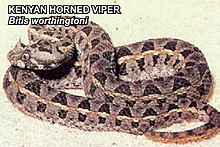Bitis worthingtoni
| Bitis worthingtoni | |
|---|---|

| |
| Scientific classification | |
| Domain: | Eukaryota |
| Kingdom: | Animalia |
| Phylum: | Chordata |
| Class: | Reptilia |
| Order: | Squamata |
| Suborder: | Serpentes |
| Family: | Viperidae |
| Genus: | Bitis |
| Species: | B. worthingtoni
|
| Binomial name | |
| Bitis worthingtoni | |

| |
Bitis worthingtoni, also known commonly as the Kenya horned viper[1][4] and the Kenyan horned viper,[5] is a species of venomous snake in the subfamily Viperinae of the family Viperidae. The species is endemic to Kenya.[1][4] There are no subspecies that are recognized as being valid.[4][6]
Etymology
The specific name, worthingtoni, is in honor of British zoologist Edgar Barton Worthington,[5] collector of the first specimen.[4]
Common names
Common names for B. worthingtoni include Kenya horned viper[1][4][7][8] and Kenyan horned viper.[5]
Description
B. worthingtoni usually grows to a total length (including tail) of 20 to 40 cm (7.9 to 15.7 in), with a maximum total length of 50 cm (20 in).[7][8]
Geographic range and habitat
The preferred natural
Reproduction
B. worthingtoni is viviparous.[4]
Conservation status
In 2004, a proposal was submitted by Kenya to have B. worthingtoni listed on CITES Appendix II. The actual status of the species was unknown, but it was reasoned that the Kenyan proposal was justified due to the species' restricted geographic range, habitat loss, demand by reptile collectors and the existence of illegal trade.[9] In 2019, B. worthingtoni was listed as "Vulnerable" by the International Union for Conservation of Nature.[1]
References
- ^ . Retrieved 19 November 2021.
- ^ "Appendices | CITES". cites.org. Retrieved 2022-01-14.
- ^ ISBN 1-893777-01-4(volume).
- ^ a b c d e f Bitis worthingtoni at the Reptarium.cz Reptile Database. Accessed 3 February 2022.
- ^ ISBN 978-1-4214-0135-5. (Bitis worthingtoni, p. 289).
- ^ "Bitis worthingtoni". Integrated Taxonomic Information System. Retrieved 3 February 2022.
- ^ ISBN 0-89464-877-2.
- ^ ISBN 0-88359-029-8.
- ^ "Bitis worthingtoni ". CoP13 at Species Survival Network. Accessed 8 October 2006.
Further reading
- Fleck J (2003). "Bemerkungen zur Kenia-Hornpuffotter, Bitis worthingtoni, sowie Beobachtungen bei der Haltung und Vermehrung [= Comments on the Kenya puff adder, Bitis worthingtoni, with observations on its care and breeding]". Elaphe 8 (3): 20-23. (in German).
- Parker HW (1932). "Scientific results of the Cambridge Expedition to the East African Lakes, 1930–1. — 5. Reptiles and Amphibians". Journal of the Linnean Society of London, Zoology 38: 213-229. (Bitis worthingtoni, new species, p. 221).
- ISBN 978-1472935618. (Bitis worthingtoni, p. 581).

